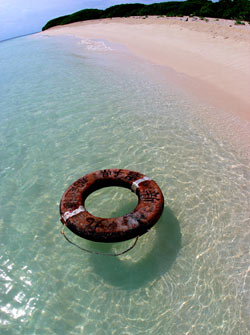
Ship Reporting Requirements
REQUIRED E-MAIL NOTIFICATION FORMATExample for Entry Notification: A/OCEAN VOYAGER/C5FU8/BAHAMAS/IMO 9359165// (Vessel Name/Call sign/Flag/IMO ID number) -OR- (series of waypoints and speed) L/WP/2734N/17352W/20.5// Example for Exit Notification: A/OCEAN VOYAGER/C5FU8/BAHAMAS/IMO 9359165// (Vessel Name/Call sign/Flag/IMO ID number) |
Vessels Required to Provide Notification:
- United States registered vessels regardless of size;
- All foreign vessels greater than 300 gross tons and that are either going to or coming from a U.S. port or place;
- Foreign vessels of any size that are heading to or coming from a U.S. port or place that are experiencing an emergency while crossing the reporting area.
All ships other than those described above, including sovereign immune vessels ***, are encouraged to participate.
Notification Procedure
Vessel passage without interruption through Papahānaumokuākea Marine National Monument (Monument)) requires entry and exit notification. For all three types of vessels listed above that have e-mail capability, an entry notification is required upon entering the reporting area (area extending 10 miles out and entirely around the PMNM boundary) and an exit notification upon exiting the reporting area. Entry and exit notifications should be provided in the above required IMO format and syntax.
For vessels of the United States less than 300 gross tons that do not have onboard e-mail capability, notifications are required by e-mail (e.g., from home or office), telephone, or fax (see contact information on right side bar) not less than 72 hours but not more than one month prior to entering the Monument for uninterrupted passage and within 12 hours of departing the Monument. Entry notifications for these vessels should include the following information: Vessel identification information (e.g., name, call sign, flag, IMO identification number), date and time of entry, position (as applicable), destination and estimated time of arrival, intended route through the Monument and the reporting area, vessel draft, categories of hazardous cargoes on board (as applicable), any vessel defects of deficiencies that restrict maneuverability or impair normal navigation, contact information for the vessel's agent or owner, vessel size (length overall, gross tonnage) and type, and total number of persons on board. Exit notifications for these vessels should include: vessel identification information (e.g., name, call sign, flag, IMO identification number), date and time of exit, position, and any pollution incident or goods lost overboard within the Monument, reporting area, or the U.S. EEZ. All reports should be in English.
Further reports should be made whenever there is a change in navigation status or circumstances, particularly in relation to item L, Q or R of the reporting format. Vessels required to provide notification that are navigating through an Area to Be Avoided (ATBA; see map and coordinates here) must report when leaving the Reporting Area and entering the ATBA and again when leaving the ATBA and re-entering the Reporting area.
If reports are not submitted by those vessels required to report and the vessel can be positively identified, appropriate action will be taken.
Why Is Vessel Notification Mandatory?
The objective of the CORAL SHIPREP ship reporting system is to increase knowledge of ship movements and facilitate a timely response to any developing maritime emergencies.
The 10 nautical mile wide reporting area surrounding the Papahānaumokuākea Marine National Monument serves to remind vessels of the existence of this important Particularly Sensitive Sea Area before they enter and allows sufficient time to comfortably alter their course to comply with the International Maritime Organization (IMO)-adopted Areas To Be Avoided.

In the event of a maritime emergency, vessel notifications serve as valuable background information to coordinate response efforts in this remote area. Credit: James Watt.
* Categories of hazardous cargoes means goods classified in the International Maritime Dangerous Goods (IMDG) Code; substances classified in chapter 17 of the International Code for the Construction and Equipment of Ships Carrying Dangerous Chemicals in Bulk (IBC Code) and chapter 19 of the International Code for the Construction and Equipment of Ships Carrying Liquefied Gasses in Bulk (IGC Code); oils as defined in MARPOL Annex 1; noxious liquid substances as defined in MARPOL Annex II; harmful substances as defined in MARPOL Annex III; and radioactive materials specified in the Code for the Safe Carriage of the Irradiated Nuclear Fuel, Plutonium and High-Level Radioactive Wastes in Flasks on Board Ships (INF Code). Vessels may, for reasons of confidentiality, communicate that section of the report which provides information on general categories of hazardous cargo by non-verbal means prior to entering the reporting area.
** In accordance with the provisions of the MARPOL Convention, ships must report information relating to defects, damage, deficiencies, or other limitations as well as, if necessary, information relating to pollution incidents or loss of cargo. Safety related reports must be provided to CORAL SHIPREP without delay should a ship suffer damage, failure or breakdown affecting the safety of the ship (Item Q), or if a ship makes a marked deviation from a route, course or speed previously advised. Pollution or cargo lost overboard should also be reported without delay (Item R).
*** The ship reporting system adopted by the IMO specifically exempts all sovereign immune vessels such as warships and other government ships operated for non-commercial purposes from the reporting requirement. Vessel sovereign immunity is interpreted in light of relevant provisions of international instruments, such as the IMO-adopted ship reporting system, Article 36 of the United Nations Convention on the Law of the Sea, and Chapter 5, Regulation 1 of the International Convention for the Safety of Life at Sea.